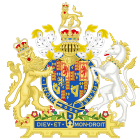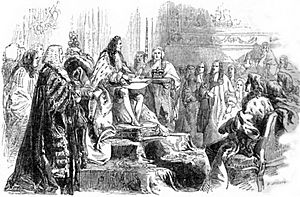Toleration Act 1688 facts for kids
| Act of Parliament | |

|
|
| Long title | An Act for Exempting their Majestyes Protestant Subjects dissenting from the Church of England from the Penalties of certaine Lawes. |
|---|---|
| Citation | 1 Will. & Mar. c. 18
|
| Dates | |
| Royal assent | 24 May 1689 |
| Repealed | 30 July 1948 |
| Other legislation | |
| Repealed by | Statute Law (Repeals) Act 1969 |
|
Status: Repealed
|
|
| Text of statute as originally enacted | |
The Toleration Act 1688 was a very important law in England. It is also called the Act of Toleration. This law was passed by the Parliament of England on May 24, 1689. It came after a big change in power known as the Glorious Revolution.
This Act gave more freedom to certain Protestants. These were people who did not follow the official Church of England. They included groups like Baptists, Congregationalists, and English Presbyterians. They had to promise loyalty to the King and Queen. They also had to reject a Catholic belief called transubstantiation.
The Act allowed these Protestants to have their own places of worship. They could also have their own schoolteachers. However, they still had to take special oaths of loyalty.
The Act did not help everyone. It did not apply to Roman Catholics, Jews, or people who did not believe in the Trinity (like nontrinitarians). It also did not apply to atheists. These groups still faced difficulties. They could not hold government jobs or go to universities. Protestant dissenters had to register their meeting places. They were not allowed to meet in private homes. Their preachers also needed special permission.
Over time, people worked to change this law. Between 1772 and 1774, a person named Edward Pickard led efforts to update the Act. His attempts were not successful at first. But in 1779, the Act was changed. It no longer required belief in the Thirty-Nine Articles of the Anglican Church. Instead, it asked for belief in the Bible. However, some problems for non-Anglicans still remained. Laws against Unitarians were finally removed much later, in 1813.
Contents
Why Was This Act Needed?
Before this Act, many people faced problems because of their religion. During the time of King Charles II, Protestants who were not part of the Church of England, and also Roman Catholics, were treated unfairly. They could not hold official jobs.
When James II, a Roman Catholic, became king, things got complicated. He tried to allow Catholics to hold important jobs. He wanted to get rid of laws called the Test Acts. These laws made it hard for Catholics and some Protestants to work in government. King James II tried to change these laws without Parliament's approval. This caused big problems.
These problems led to the Glorious Revolution. As a result, William and Mary became the new King and Queen. After they took the throne, several new laws were passed. These laws helped set up a new way of governing England. The Toleration Act was one of these important new laws. Others included the Bill of Rights 1689 and the Act of Settlement 1701.
Historians say the Toleration Act was a compromise. It helped get support from Protestants who were not part of the Church of England. Both the Whig and Tory political groups had promised this Act. They wanted to gain support for William and Mary.
Even after the Act, Catholics and Unitarians still faced challenges. They could not legally gather to pray. Also, non-Anglicans, including Protestants not in the Church of England, Jews, Catholics, and Unitarians, could not be members of Parliament. This was because of the Test Act, which stayed in place for a long time.
Who Influenced This Act?
Many historians believe that a famous thinker named John Locke had a big impact on the Toleration Act. He wrote a book called A Letter Concerning Toleration in 1685. It was published in 1689. In his book, Locke argued that different Protestant groups should be allowed to practice their religion. He believed they could live peacefully alongside the Church of England.
However, Locke did not include Catholics in his idea of toleration. The Toleration Act followed a similar idea. It gave freedom to many Protestant groups but not to Catholics.
How It Affected the Colonies
The ideas of the Toleration Act also spread to the English colonies in America. In many colonies, people started to accept more religious freedom. This was true even in places like New England. These areas had previously been strict about religion.
Some colonies went even further than the Act. Pennsylvania, Rhode Island, Delaware, and New Jersey did not have an official church. They allowed many different religions to thrive. By the year 1700, Rhode Island was one of the few places where Roman Catholics could freely practice their religion.
Later Changes to Religious Freedom
Over the years, religious freedom continued to grow. In 1813, Protestants who did not believe in the Trinity (like Unitarians) were finally given more rights. Catholics also gained more freedom to worship under certain rules in 1791.
Many old laws that stopped non-Anglicans from holding public jobs were removed. These changes happened through various new laws. For example, the Roman Catholic Relief Act 1829 allowed Catholics to be elected to Parliament. The Jews Relief Act 1858 did the same for Jewish people.
By 1846, the Religious Disabilities Act ended many restrictions on Catholics. They could now get an education, run charities, and own property more freely. However, some universities still kept Catholics out until 1871. By 1855, a system was set up to register non-Anglican places of worship. This gave them certain legal benefits. It showed that having a different religion was not only allowed but often supported by law.
See also
- Catholic Emancipation
- Freedom of religion
- Maryland Toleration Act – a law that gave Protestants and Catholics the right to worship freely in Maryland
- Religious toleration
- Religion in the United Kingdom


